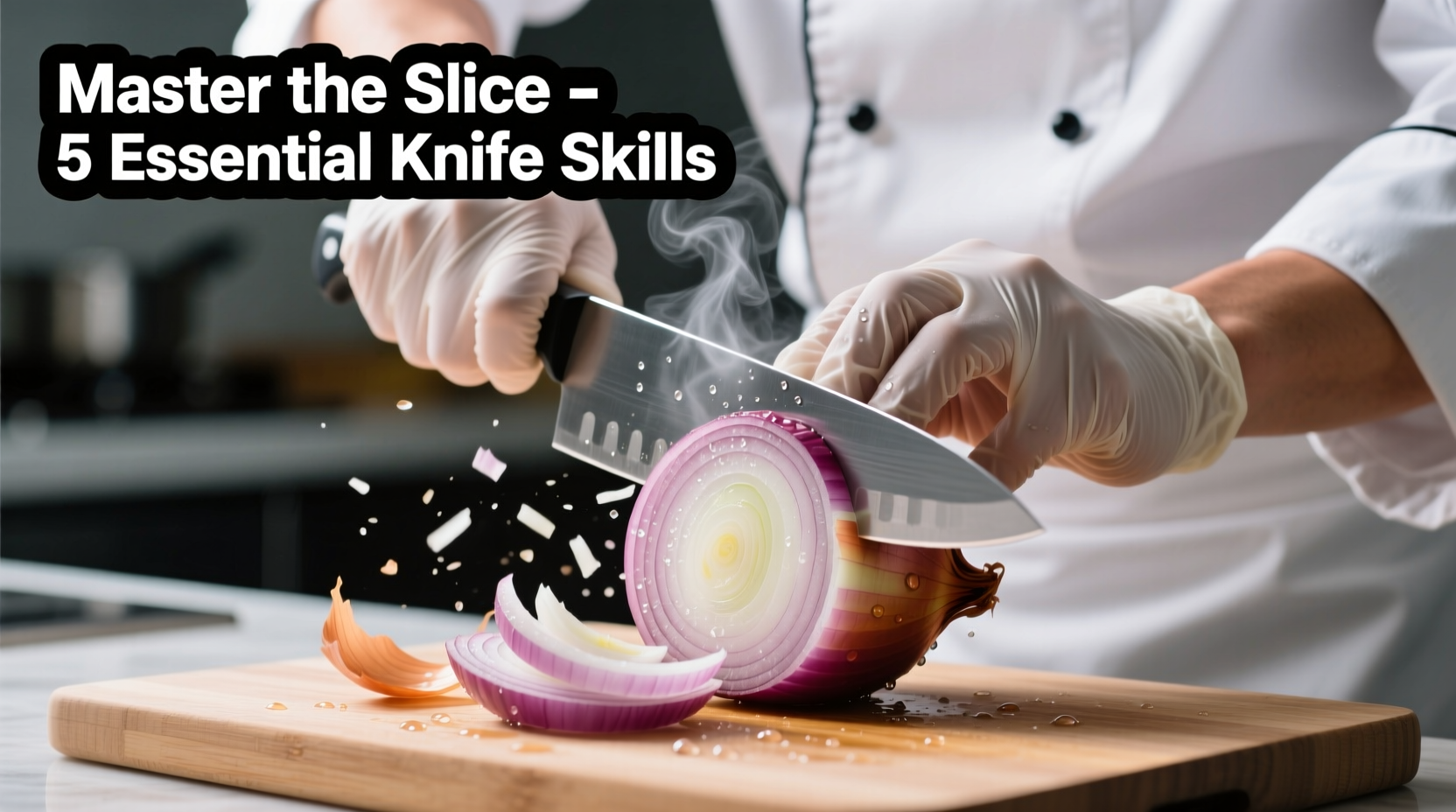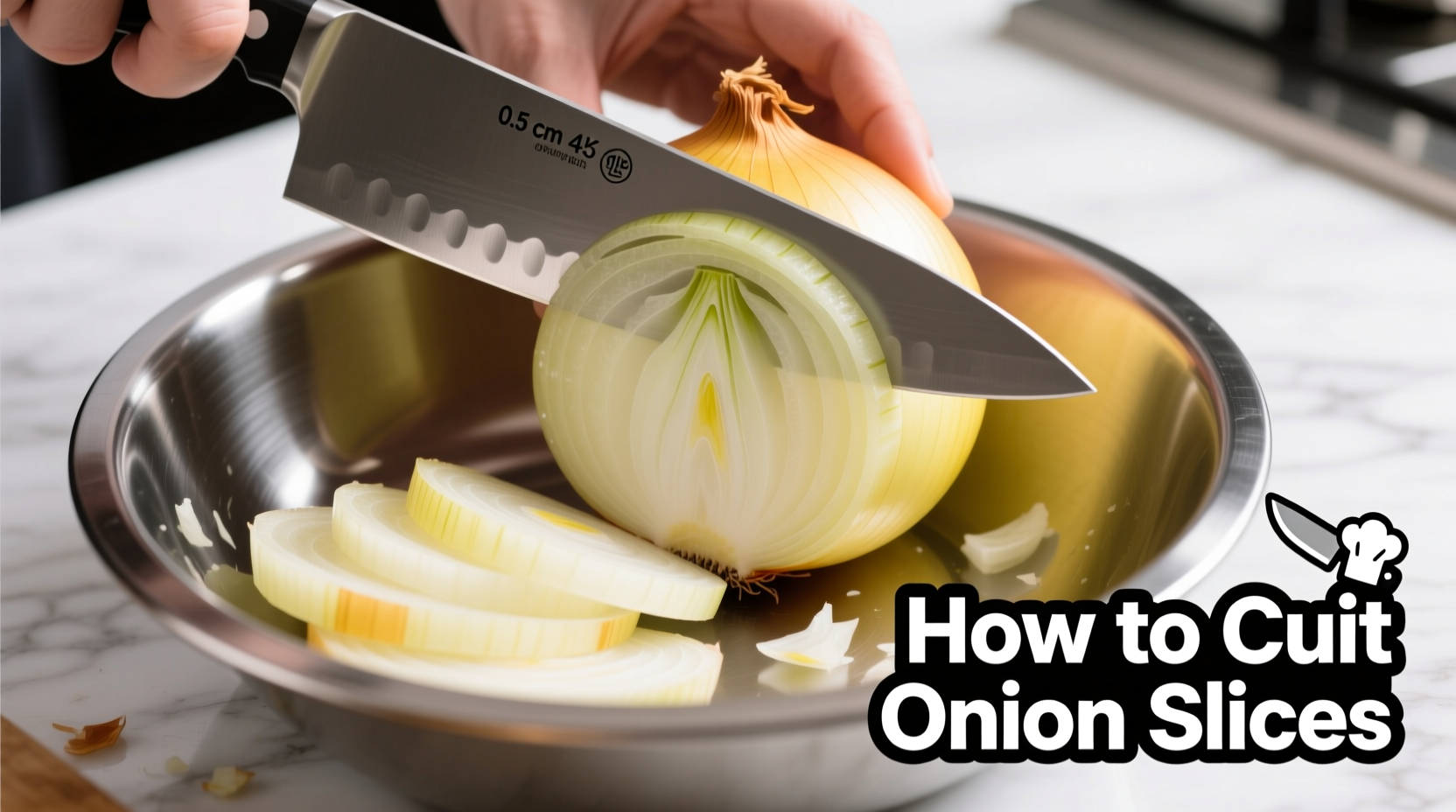Mastering the art of slicing onions transforms your cooking experience. Properly cut onion slices ensure even cooking, better flavor distribution, and professional-looking dishes. Whether you're preparing a French onion soup, fajitas, or a simple salad, the right slicing technique makes all the difference. In this guide, you'll learn the exact method professional chefs use to create perfect onion slices every time—without the tears.
Essential Tools for Perfect Onion Slicing
Before you begin, gather these kitchen essentials:
- A sharp 8-inch chef's knife (dull knives crush onion cells, releasing more tear-inducing compounds)
- A stable cutting board (wood or plastic works best)
- A bowl of cold water (for tear prevention)
- A damp kitchen towel (alternative tear prevention method)
Step-by-Step Onion Slicing Technique
Preparing the Onion
Start with proper preparation to maximize efficiency and minimize irritation:
- Trim 1/4 inch from both the root and stem ends using a downward slicing motion
- Peel away the papery outer skin and first layer
- Place the onion flat-side down on your cutting board for stability
- Cut vertically through the root to divide the onion in half
Creating Perfect Slices
Follow these precise steps for uniform slices:
- Place each half flat-side down with the root end facing left
- Make horizontal cuts from the top toward the root (about 1/4 inch apart), stopping before reaching the root
- Rotate the onion 90 degrees so the root points away from you
- Starting from the root end, make vertical slices toward the top at your desired thickness
- The onion will separate into perfect, even slices as you cut

Onion Slicing Variations for Different Culinary Applications
Understanding when to use different slice types elevates your cooking results. The American Culinary Federation recommends matching your slicing technique to the dish's requirements:
| Slice Type | Thickness | Best Culinary Uses | Preparation Time |
|---|---|---|---|
| Julienne | 1/8 inch | Stir-fries, garnishes, French onion soup | 2-3 minutes |
| Standard Slices | 1/4 inch | Burgers, sandwiches, sautés | 1-2 minutes |
| Thick Slices | 1/2 inch | Grilling, onion rings, kebabs | 1 minute |
| Half-Moons | Variable | Salads, salsas, quick cooking dishes | 30-60 seconds |
Science-Backed Methods to Prevent Onion Tears
According to research published by the American Chemical Society, onions release syn-propanethial-S-oxide when cut, which reacts with moisture in your eyes to form sulfuric acid. Try these evidence-based solutions:
- Cool your onion in the refrigerator for 30 minutes before cutting (reduces volatile compound release)
- Use a very sharp knife to minimize cell damage (https://www.acs.org/)
- Cut under a vent or near running water to disperse the compounds
- Wear kitchen-safe goggles for complete protection
Avoid These Common Onion Slicing Mistakes
Even experienced home cooks make these errors that compromise results:
- Slicing through the root end - Causes the onion to fall apart; always leave the root intact until final slices
- Using a dull knife - Crushes cells and releases more tear-inducing compounds
- Cutting against the grain - Results in uneven cooking; always slice perpendicular to the onion's natural rings
- Rushing the process - Leads to uneven slices; proper technique takes just 60-90 seconds
When Different Slice Types Matter Most
Professional chefs at the Culinary Institute of America emphasize that slice thickness directly impacts cooking results. Thin slices (1/8 inch) work best for dishes requiring quick cooking like French onion soup, where even caramelization is critical. Medium slices (1/4 inch) provide the ideal balance for most applications, maintaining structure while cooking through properly. Thick slices (1/2 inch) are essential for grilling or when you want distinct onion pieces that hold their shape.
Advanced Technique: Creating Onion Rings Without Waste
For perfect onion rings with minimal waste:
- Follow the standard preparation steps
- Instead of halving, cut horizontally at your desired ring thickness
- Separate the rings carefully by hand
- Use the center core for stocks or finely chopped applications
Frequently Asked Questions
Q: How can I cut onions faster without sacrificing quality?
A: Practice the "claw grip" technique with your non-knife hand, keeping fingertips curled under. This protects your fingers while guiding the knife for consistent slices. With practice, you'll reduce cutting time by 30-40% while maintaining precision.
Q: Why do my onion slices stick together after cutting?
A: This happens when you slice too aggressively through the root end. Always leave the root intact during horizontal and vertical cuts, then remove it after slicing. The root holds the onion layers together during cutting but should be discarded afterward.
Q: What's the best way to store cut onions?
A: Place sliced onions in an airtight container with a slightly damp paper towel. Refrigerate for up to 5 days. For longer storage, blanch slices for 60 seconds in boiling water, then freeze in portion-sized bags for up to 6 months.
Q: Can I use a food processor to slice onions?
A: While convenient, food processors often create uneven slices and release more tear-inducing compounds due to rapid cell destruction. For best results in most recipes, hand-slicing provides superior texture and appearance.











 浙公网安备
33010002000092号
浙公网安备
33010002000092号 浙B2-20120091-4
浙B2-20120091-4